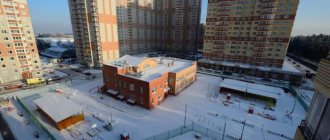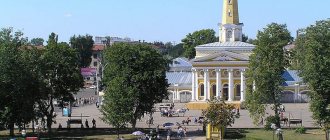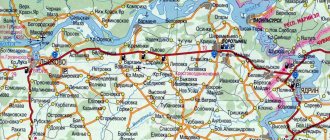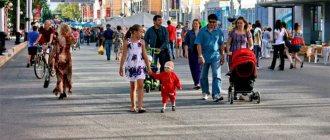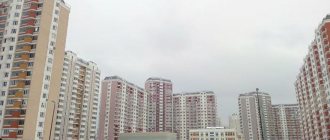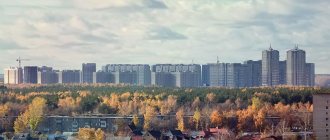Podolsk is the administrative center of the urban district of the same name (the only populated area within it), one of the largest satellites of Moscow. The city is located 15 km from the Moscow Ring Road and only 36 km from the center of the capital. On the territory of the settlement there are about 2 dozen industrial enterprises, which provide jobs to a significant part of the local population and are the basis of the city’s economy.
The population is about 310 thousand people, it has had city status since 1781. Currently, there is a developing trend towards Moscow gradually absorbing the near Moscow region and merging settlements into a single metropolis. Can today’s Podolsk be considered part of the capital or is it too early? Let’s look at it in this article.
The first settlements on the Pakhra River (a tributary of the Moscow River) arose in ancient times (settlement by the Slavs dates back to approximately the 10th century). In the 14th century, these territories were already part of the Moscow Principality; the river served as a reliable water route between local villages and the capital, the main one among which was the village of Podol.
Podolsk received city status by decree of Catherine II, at the end of the 18th century.
During Soviet times, especially starting from the 1930s, the city experienced rapid industrial growth.
Today the settlement is one of the developed industrial centers of the Moscow Region. The consumer sector is well developed, the city has the same shops, cafes, salons and representative offices of large retail chains as in the capital, there is a ski resort and cultural and leisure centers. Podolsk is actively being developed with new square meters of living space, including as part of the implementation of state projects. programs for the resettlement of dilapidated housing. The cost per square meter still remains below Moscow.
General information about the city and a little history
Like many other Russian cities with a centuries-old history, Podolsk also has a legend describing how the name itself appeared.
According to some “experts,” allegedly somewhere in these places, while passing through the village, the Empress of All Rus' Catherine II wet the hem of her outfit. Podolsk
The story is, of course, funny, but nothing more. She could visit these places, but she ruled from 1762 to 1796. Considering that historians date the appearance of the first settlements in these places to the 7th millennium BC, and references to the local village of Podol are in documents from the time of Ivan the Terrible, it is not difficult to guess that this German woman, who came to power as a result of a palace coup, has nothing to do with has nothing to do with the name Podolsk. On the other hand, it was she who signed the decree transforming the village into the city of Podol-Pehra (1781).
The proximity to Moscow and the presence of transport routes nearby are the reason why many historical events are associated with Podolsk. If you don’t delve too deeply into the depths of centuries, you can note such things as the presence of Kutuzov’s army here during the Patriotic War of 1812, the military actions of cadets of the local military school, who helped delay the advance of German troops in 1941 to the capital, which then significantly helped in organizing defense of the capital. Currently, Podolsk is one of the largest settlements in the Moscow region. It houses a fairly large number of industrial and scientific organizations, some of which are of federal importance.
Night Podolsk
Podolsk is located south of Moscow, at a distance of approximately forty kilometers from its center. It stands on the banks of the Pakhra River, and modern transport arteries that pass through the city include the Moscow-Simferopol railway and the M-2 Crimea highway. The latter, by the way, is quite a serious irritant for the local population. In addition to the fact that its overload already created quite serious inconveniences, the latest decisions to change the route led to the fact that part of the private sector will be demolished, and the level of corresponding compensation is unlikely to satisfy homeowners.
Transport and communication with Moscow
Internal transport links in the city are based on buses and trolleybuses, and there are minibuses.
Podolsk is located near the federal highway M-2 (“Crimea”), along which the capital can be reached either by private car or by bus or minibus. The nearest metro station is “Lesoparkovaya”, most of the public transport goes to it (exception No. 407, which can be used to get to the stations “Anino” and “Dmitry Donskoy Boulevard”).
Other ways to get to Moscow:
- by train from the Podolsk railway station (full-fledged, stone) and two additional platforms: “Silikatnaya” and “Kutuzovskaya”. Traffic is carried out along the Moscow-Kharkov railway line;
- MCD-2 (Moscow Central Diameters), is a ground-based analogue of the metro, opened in November 2022, connects Podolsk with Nakhabino, passing through the entire capital. The frequency of electric trains here is approximately 12 minutes, there are no traffic jams, and there is the possibility of a free transfer to the “classic” metro.
The implementation of the MCD project has significantly simplified the connection between Podolsk and the capital, bringing both cities even closer together.
Climate and ecology of Podolsk
The climate here is quite familiar, if we speak in scientific terms - “temperate continental”. In practice, this means that winters here are relatively mild. The metropolis, which is warmer by definition, also probably has a certain influence, since the Moscow Ring Road is only fifteen kilometers from here. Frequent thaws and melting snow underfoot are a common sight. According to statistics, the maximum precipitation here falls in the summer, so the warm season is not particularly pleasant, since there is a lot of cloudiness and fogs are not at all rare.
One of the interesting features is that the hour meridian passes through my city. This means that no matter what next change in time is not accepted by our Duma or government, people will always be able to find themselves in space an hour earlier or later, at will. To do this, it is enough to move from the western part of Podolsk to the eastern, or vice versa.
Sources of pollution in Podolsk
The environment in Podolsk is far from ideal. If the wind blows from the north, then, as mentioned above, you feel the “fresh breath” of the metropolis. It also has its own sources of pollution. The main ones are the highway to the south and enterprises remaining from the times of Soviet power that have not yet been closed. These fragments of their former power are still being smoked little by little. Therefore, the most unfavorable conditions are where they are located, in the eastern and northeastern parts of the city.
Population of Podolsk
The demographic situation in Podolsk, as in other settlements, is determined by various factors. One of them is the industrial development of this place. Before the revolution of 1917, quite rapid activity in this direction began here, and therefore the number of residents during this period quickly grew from a couple of thousand people to more than 10,000.
The next surges, caused by the same reasons, took place before and after the Great Patriotic War. It was the largest local enterprises that began to operate, which was reflected in the statistical data.
May 9 in Podolsk
The maximum number of officially registered residents of the city was recorded in 1989 and was then 207,800 people. The overthrow of the communists and subsequent years - a decrease to the level of 180 thousand.
Since 2007, a period of growth began again. If we quote the numbers again, then, according to the available data, the main increase today comes not from an increase in the birth rate, but from an influx of migrants. Moreover, if officially there are less than two hundred thousand people in Podolsk, then according to other sources there are already 40,000 more people actually living here.
Future prospects
In the future, there will be oncoming residential development in the direction from Moscow to Podolsk. In addition, the economy of the satellite city is closely connected with the capital city; a significant part of the products is intended either for the capital or goes to the regions through its logistics hubs.
The MCD lines are a project connecting Moscow with the territories of the Moscow Region into a single structure. Further development in this direction, coupled with the development of the Moscow region with new residential areas (which is caused by a shortage of free land in the capital) will lead to the emergence of a huge metropolis on the site of today’s independent administrative units.
The standard of living in today's Podolsk is not much different from Moscow. The city has enough paid jobs and getting to the capital has become even easier after the launch of the Podolsk-Nakhabino ground metro line. At the same time, the settlement is well developed and self-sufficient, and has all the necessary social and infrastructure facilities on its own territory. The economic prerequisites are all met, but there is currently no need for a formal unification of Podolsk with Moscow. In the future, this may happen as a result of the convergence of residential areas.
Districts and real estate of Podolsk
Geographically, the city is divided into fourteen districts: Krasnaya Gorka, Novo-Syrovo, Parkovy, Zalineiny, Central, Zelenovsky, Ivanovsky, Mezhshoseyny, Yubileiny, Kuznechiki, Fetishchevo, Vysotny, Shepchinki and Kutuzovo. Each of them has its pros and cons. Let's look at each district in detail, for convenience - in alphabetical order.
Podolsk map
The Vysotny district has very favorable living conditions. It is here that the Vityaz ice stadium is located. The Podolsk Tennis Academy is also located nearby. At the same time, in the Vysotny district there are several forest park areas, including the largest forest park in the city, “Dubki”. The area is built up with modern multi-storey buildings. In addition, it is in Vysotny that the two largest utility companies are located, which are of strategic importance for the entire Moscow region, especially for the southern Moscow region.
In terms of area, the Zalineiny district is the largest. Therefore, it is additionally divided into 4 microdistricts: Yuzhny, Severny, Dobryatino and the village of Selkhoztekhnika. It is in this area that the main industrial production of the city, as well as warehouses and terminals of large enterprises, are concentrated. However, despite the significant industrial bias, the Eden Hotel and two cultural palaces are located in the Zalineiny district. The main housing stock is high-rise buildings. However, there is also a small private sector.
Zalineiny district of Podolsk
Zelenovsky district can be safely called central both in terms of importance and level of residence. This is where the city administration, police department, prosecutor's office and city court are located. The area is located on the banks of the Pakhra River and is currently being actively developed with modern multi-storey residential complexes. But at the same time, most of the area of the Zelenovsky district is occupied by the private sector. There are especially many private houses near the Pakhra River. The area is quite safe and crowded. This is confirmed by the fact that this is where McDonald's is located.
The Ivanovsky district of Podolsk is also known as the village of Volodarsky. This is roughly what it looks like - most of the area is occupied by the private sector, there are almost no high-rise buildings, most of the houses are five-story. The area is quiet and cozy. An important point - this is where school No. 29 is located - the best school in the Moscow region.
Vladimir Putin’s visit to school No. 29 in Podolsk
The Krasnaya Gorka district is located along one of the main highways of Podolsk, which leads to Moscow. Nowadays, multi-storey housing is being actively built here. At the same time, old and dilapidated housing is being methodically demolished, of which there is still more than enough here, since most of the area is occupied by the private sector. Nearby is the Erino sanatorium.
Krasnaya Gorka area
The Kuznechiki district is definitely a residential area of Podolsk. It is located on the very outskirts of the city. Now the area is being intensively built up with high-rise buildings; it is planned that this will be the most densely populated area with developed infrastructure. Another highlight of the area is the Favorit equestrian center.
Kuznechiki District of Podolsk
Kutuzovo is another residential area of Podolsk. The area is adjacent to the Kutuzovskaya railway station and actually borders the neighboring town of Klimovsk. Most of Kutuzovo belongs to the private sector. From a crime point of view, this is not the safest area of the city.
Kutuzovo
The symbolic name of the Mezhshoseiny emphasizes its central position between the main highways of Podolsk. Most of the houses are modern, multi-story. There is a developed network of convenience stores here, so the area is considered very favorable for living. In addition, the largest stadium in the city “Trud”, the oldest cinema “Rodina” and the modern shopping and entertainment complex “Auchan Capitol” are located here. In addition, this is where many of the socially significant objects of Podolsk are located.
Interhighway
The Novo-syrovo district ranks second in area among the districts of Podolsk and is divided into 3 microdistricts: Vypolzovo, the village of Tsementogo and Silikatnaya. There are many industrial enterprises and large shopping centers here, including retail premises of large car dealers in Podolsk. Modern new buildings in the area are now mainly at the construction stage.
The park district got its name from the park of culture and recreation named after. Talalikhin, which is located here. This is a residential area built up with high multi-storey buildings.
Park named after Talalykhina
The Fetishchevo district can now be called rather developing. It is being built up with modern multi-storey buildings, infrastructure and retail facilities. At the same time, a significant part is occupied by the central archive of the Russian Ministry of Defense. The Archive of the Ministry of Defense in Podolsk is the main archive of the Ministry.
Fetishchevo District
The central district is the business center of Podolsk. It is replete with cafes, restaurants, shopping malls, and beauty salons. At the same time, the oldest enterprises of the city have been preserved here. Housing is represented mainly by old stock. But the area's elite five-story buildings are sometimes interspersed with modern high-rise buildings.
Central district of Podolsk
The Shepchinki district arose when the village of the same name was annexed to the city. Therefore, it is not surprising that the urban part of the area gradually turns into cottages and dachas. There are many old two- and four-story houses in the area. Now the territory is being actively developed, not only modern houses and large shopping, grocery and construction centers are being built.
Demolition of dilapidated housing in Shepchinki
The Yubileiny district can easily be called the most modern district of Podolsk. More recently, multi-storey residential complexes were built here. Infrastructure facilities are now being actively developed. There are both convenience stores and one of the largest shopping malls.
Anniversary
Generally speaking, we can note the fairly high attractiveness of this locality if you choose a place to live. Territorial proximity to Moscow and at the same time sufficient remoteness so as not to experience all the hardships of a multimillion-dollar metropolis. There are all the necessary communications and developed infrastructure, and at the same time, on the outskirts, you can choose housing in low-rise buildings - and be closer to nature. All these delights are a sufficient reason for construction companies to be highly active. This is how it really is. Today in Podolsk you can find real estate for every taste. There are both elite new buildings here and those where you can try to find a cheaper apartment.
Let us immediately note that recently the authorities have begun to be active in relation to certain types of housing, which are being built with obvious signs of fraud. We are talking about the construction of apartment buildings, the permitting documents for which implied the construction of other buildings of a much smaller scale. Such objects are usually located in dacha cooperatives and villages. There are similar buildings in the Podolsk region, for example, near the village. Borodino, Bykovka, Erino, in the village of Pokrov and Ostafyevo. Therefore, if you are choosing a suitable property, you should approach this issue with caution.
One of the new buildings in Podolsk
At the same time, there are also quite good proposals here. When determining, do not forget about the environmental situation. It will not be too valuable and correct from a health point of view to be located in the north and northeast of the city, in its industrial part. You should also take into account the passage of a new highway, so as not to get into trouble on the secondary housing market, when the state will pay only a tiny part of its real cost for a house to be demolished. The general price level is already approaching the Moscow level of cheap housing, but there are plenty of interesting options.
If you need to make a choice, you can use the Podolsk Committee for Construction and Architecture as a source of additional information. Here you can, on a completely official basis, obtain data on “long-term construction”, specific stages of implementation of individual construction projects. For example, in new buildings on Krasnogvardeisky Boulevard, the sale of apartments is in full swing (judging by the advertising), and yet the completion of work there has been delayed for several years. Therefore, there is no need to be shy - although the district administration is not ideal, like everywhere else, it is possible to obtain certain data there.
Well, in conclusion, on the topic of housing, we can say that in accordance with existing plans for the expansion of Moscow, new territories will be transferred to the capital from the Podolsk region, but the city itself will not be annexed to them.
Zalineiny district. Part I
This part of Podolsk got its name because of its location - since 1869 it has been separated from the city center by the line of the Moscow-Kursk Railway. This is one of the darkest and, at the same time, most interesting areas of the city. Enterprises and industrial zone
Near the Podolsk station Until the beginning of the twentieth century, the area behind the railway was practically not developed. Only in 1915, during the First World War, the construction of a large cable plant of the Moscow Association of Copper Rolling and Cable Plants began here. They never had time to complete the construction due to the events of 1917. In 1919-20, during the Civil War, an enterprise for the repair of steam locomotives was created on its basis, which was strategically important for the Bolsheviks. The first locomotive left the overhaul on September 2, 1920. In 1930 it was once again repurposed. It began to be called cracking-electric locomotive-building (CES) and produced oil equipment and electric locomotives for mines. In addition, he also produced tubes for the Moscow metro. On April 8, 1936, the plant was named after the People's Commissar of Heavy Engineering Sergo Ordzhonikidze. In the 1930s, near the entrance overlooking Zheleznodorozhnaya Street, a sculpture of him was installed, dressed in a characteristic long overcoat.
Monument to Ordzhonikidze Around the plant in the 1910-30s, two large villages were formed - Northern and Southern.
Twin water towers on Bronnitskaya Street In the 1920s-60s, others appeared in the Zalineinnaya part of the city, a battery tower, etc. They formed a vast industrial zone. Judging by my observations, there are quite a lot of interesting structures in it (according to fairplay , the battery plant even has a water tower designed by Shukhov). Alas, I have not yet been able to get into the factories and inspect them in detail.
Block building in an industrial zone. Obviously, the construction was from the 1920s. For now, I’ll move on to the story about the sights of the residential areas of the Zalineiny district. Basically, we will talk about the villages of North and South. The first of them contains the most interesting buildings of the 1910-30s, the second contains colorful buildings of the 1940-50s. Severny Village Severny Village, as its name correctly indicates, is located on the north side of the Ordzhonikidze Plant. Here are the plans for two of its districts with the most valuable development:
Most constructivist buildings from the late 1920s are labeled as 1930s to avoid confusion with houses from 1923. 1910s The oldest buildings in Severny were obviously built just before the revolution and can be classified as examples of late modernism. This is a two-story house with neoclassical features (Orzhonikidze, 4) and symmetrically located workers' barracks (Orzhonikidze, 11 and 13).
Ordzhonikidze, 13. Right building 1915
Ordzhonikidze, 11. Left building 1915 Nowadays, the workers' barracks (Ordzhonikidze, 11 and 13) still house factory dormitories. If it were not for the bright red-yellow color of the walls (this is a traditional color scheme for Podolsk), these buildings would be very modest. The only striking detail that allows us to classify them as modern is
A giant flowerpot in summer A small square in front of the barracks is decorated with a giant multi-colored Stalinist flowerpot () and
Mira, 6. The front facade facing the courtyard has many features of pre-revolutionary architecture.
Mira, 6. The rear facade is much more similar to its counterparts of the 1920s. Another building (Mira, 6) should be classified as a transitional type - it has features of both pre-revolutionary and Soviet architecture. By analogy with the famous houses on Chkalova Street in Krasnoarmeysk near Moscow, I would also date it to the mid-1920s. 1923
House from 1923. The courtyard facade, also known as the main façade. The oldest Soviet buildings (at least those that are dated) in this quarter were erected in 1923. Let me remind you that in this year the construction of stone housing in the USSR was extremely rare. Here we see not just a separate house, but a small ensemble formed near the pre-revolutionary workers' barracks. These are houses 8 and 10 on the current Mira Street (it would be interesting to know what it was called in the 1920s).
House from 1923. Rear view, from the small street Mira Rubezh 1920-30s The second wave of buildings in Severny appeared already in the late 1920s - early 1930s. The houses built near the western factory entrance on Zheleznodorozhnaya Street (No. 14) and in the Northern Dead End (No. 3, No. 5) have a strict and gloomy appearance, traditional for the constructivist architecture of the Moscow region near the factory.
Zheleznodorozhnaya, 14. Gloomy house with a grocery store
In the Northern Dead End Adjacent to the workers' barracks quarter, the constructivist buildings on Ordzhonikidze (No. 9) and Severnaya (No. 1 and No. 2) streets are more festive. If house No. 1 is a striped three-story building common for those years, then houses No. 9 and No. 2 are very harmonious and interesting examples of constructivism.
Ordzhonikidze, No. 9. Constructivist house from the late 1920s. This is a fairly rare type of house, but not unique - there are similar ones in Moscow, on the passage of the Cherepanov sisters in Likhobory.
Ordzhonikidze, No. 9. Rear facade 1930s Since the mid-1930s, there has been no major housing construction in the village. At that time, in Podolsk there was a ban on multi-storey construction in this part of the city - houses were built in the city center and in the Interhighway district.
Ordzhonikidze, 7. Plant management In Severny, only the impressive ZiO plant management building was built (Ordzhonikidze, 7) and located nearby, on the corner of Ordzhonikidze and Zheleznodorozhnaya streets, a village of slightly strange-looking two-story buildings.
Ordzhonikidze, 4. Neoclassical two-story building The oldest of them, N4 on Ordzhonikidze Street, despite the alterations, bears the features of neoclassicism, which most likely indicates its pre-revolutionary origin. The rest are clearly Soviet.
Ordzhonikidze, 3. Two-story building from the first half of the 1930s. Similar ones recently stood in Podolsk Kooperativny Proezd. If one of the two-story buildings (No. 3) looks typical of the early 1930s, then the others are extremely unusual due to the decoration being too relief and monumental for such modest buildings (some of them are now being reconstructed, but the original forms still visible). Perhaps the factory management once lived in these houses, which is why they were given such a solemn appearance.
Zheleznodorozhnaya, 6-8. Monumental two-story buildings (left and right). In the background you can see an old metal lantern and the side of a pre-revolutionary two-story building (in the center of the frame).
Zheleznodorozhnaya, 8-12. Monumental two-story buildings. Club
Mira, 4. Facade of the house of culture Also, judging by the forms and plan, the large building of the factory house of culture (Mira St., 4) should also be attributed to the thirties.
Mira, 4. Pediment At the end of the 1950s, it was overhauled in the late Stalinist style, receiving (like the Lepse Palace of Culture) a ceremonial pediment with figures of Soviet people. One of the molded parts is a brand new round satellite - a symbol of the coming Khrushchev era.
Mira, 4. Back of the club 1940s
On Severnaya Street Immediately after the war, housing construction in the village resumed. Several three-story houses appeared between Mira and Entuziastov streets.
Mira, 15. Red and yellow three-story building from the mid-1940s. The small passage in the foreground is Mira Street. The oldest of them are located on the corner with Northern Street (No. 7, No. 15, No. 16) - they are practically devoid of decor, but they have the yellow-red color that is already familiar to us. Obviously, they were built either immediately after the war, or in its last years, when standard series of low-rise buildings had not yet been developed.
Mira, 13. Block three-story building of the late 1940s. The remaining three-story buildings were built according to standard designs of the late 1940s - similar ones can be found in many other cities. 1950s The far part of the block was built in the early 1950s. The most curious of them - a four-story building No. 7 on Mira Street - bears on the facade the mysterious abbreviation UNR-661, lined with bricks.
Mira, 7. House with an abbreviation The houses are now somewhat dilapidated, but still retain many signs of the Soviet era - old signs on stores, courtyard layouts and stylish metal lanterns from the 1950s. On one of the walls you can see an interesting social advertisement of folk origin.
Gulevsky absolutely agrees
Polivanovskaya, 1. House with a sloping corner Another interesting block is located in the area of Gulevsky Proezd and Polivanovskaya Street - these are five-story brick houses from the second half of the 1950s. Their appearance was contradictoryly affected by three Soviet styles - Khrushchev, Stalin and constructivism. Built in transitional forms from the first to the second, they have unusual chamfered corners of the upper floors, emphasized by balconies. It seems to me that this is a purely retrospective attempt to revive the forms of architecture of the 1920s using new material.
Gulevsky, 1. Another example of the transitional style is the front bay window on the side facade of the hospital. The rest of the building is maintained in the spirit of Khrushchev's modesty. In this quarter, as well as on Mira Street, several old lanterns have been preserved. Another attraction is the authentic “Bakery” sign on one of the five-story buildings from the early 1960s, made in the style of the previous decade.
Batyreva, 4/3. "Milk" sign: 1950s design, early 1960s execution Industrial swamp The rest of the area is occupied by either industrial zones or extensive private development.
Industrial swamp In the area of Aviatsionnaya and Polivanovskaya streets, it is worth checking out a large swamp-dump with power line masts sticking out of it and unfinished industrial facilities. In summer, many seagulls nest there. There are none in winter, but it’s still romantic.
Inhabitants of the industrial swamp Next to the industrial swamp there is another miracle of architecture - a magnificent palace at the substation, built from standard concrete parts. I note that this is not the only similar structure in Podolsk - there is another one in Shepchinki.
Typical energy palace by Nikolai Kalashnikov
Source: author Nikolai Kalashnikov
Infrastructure of Podolsk
The downside to the city is the bad roads. On the other hand, it should be noted that the construction of new facilities and the reconstruction of old microdistricts is quite intensive. In parallel with this process, a partial renewal of communications is taking place, so sooner or later this problem will be solved.
Roads
Getting there on the main highway today is not always easy, as it is heavily congested. At the same time, reconstruction of this highway is underway, which inspires certain hopes. There are three railway stations in Podolsk, but I don’t recommend taking the train to the final station - this is Kursky, although Paveletsky is almost twice as close. Therefore, if you use this transport, it is best to change at a suitable metro station, getting off somewhere at Tekstilshchiki or Tsaritsyno. Buses and minibuses. With their help, you can navigate around the city itself, and get to the nearest metro station, and to other cities in the Moscow region. As an option that is not often found in such relatively small cities, we can mention the trolleybus. This type of transport is also available here. It first began to be used in 2001, and today there are four constantly operating routes.
Social and cultural life. If anyone doesn’t remember, this was the name for cultural and social facilities. The city has everything you need for a comfortable life. Shops and bank branches, clinics and hospitals, branches of higher educational institutions. If we talk about the availability of free places in preschool institutions, then according to official data it is about 90%, which is not so bad. On the other hand, it should be noted that these figures most likely also include private organizations of this type, where monthly payments are quite significant and not everyone can afford them.
We must not forget that Podolsk is one of the largest cities in the Moscow region, so there are enough infrastructure facilities of various types here. If something is missing, then the proximity of Moscow compensates for this deficiency quite effectively. As sports attractions, the ice palace called “Vityaz” and two ski slopes, each about two hundred meters long, deserve mention.
Enterprises and work in Podolsk
Oddly enough, some industrial enterprises in Podolsk survived the changes of the 90s of the last century. Among the largest are OOO, which produces units for the nuclear industry and energy facilities, ZIOSAB - boilers and boiler houses, and Chemical-Metallurgical Plant - semiconductor wafers and devices. In total, about fifty large industrial organizations and about two hundred small ones operate in the city. There are both old enterprises with a century-long history, such as (the former famous Singer), and new ones - Transformer, which produces transformers under license.
Again, on the old base, but with the addition of new technological solutions, various scientific institutions continue to work here. Their main focus is atomic research. Thus, Gidropress develops reactors of various types, and also produces small-scale batches of individual specific units and installations. Gazprom, a structure with the same name as our gas giant, is our design bureau, which designs equipment for the relevant industry, drilling rigs and other mechanisms.
In terms of the number of employees, the largest segment of city enterprises are small businesses of various forms. Of the total working population, at least 40% are involved in this area. Their activities are focused on trade, retail and wholesale, and provision of services to the population. A small part of such enterprises are small construction firms.
In addition to local entrepreneurs, federal chain retailers are also well represented in Podolsk. “Auchan” and “Perekrestok”, “Carousel” and “Pyaterochka”, “Dixie” and “Kvartal”. There are also specialized dealers in equipment (“Eldorado” and “Technosila”, “White Wind”), children’s goods (“Detsky Mir”, “Korablik”), points of sale of cellular operators, perfume chains and others.
Shopping center Karusel in Podolsk
Despite the relatively large influx of migration, the provision of jobs in Podolsk is not bad. Considering the proximity of the capital, it can be argued that anyone can always find a way to earn a living and provide for themselves and their loved ones. The higher level of salaries in Moscow determines that many people prefer to look for vacancies there. In particular, and therefore, as mentioned above, during rush hours traffic towards the capital is quite intense.
Social infrastructure
The status of a large, industrially developed city near Moscow implies progressive dynamics of population growth and the need for objects of social significance. On the territory of Podolsk the following applies:
- 4 city hospitals and 5 clinics, private medical centers, ambulance stations and a number of state-owned. honey. MO institutions;
- Ministry of Defense Hospital;
- about 30 schools and five dozen kindergartens;
- 8 universities.
Thus, the city has a complete, self-sufficient system of social security for the population, independent of the capital’s institutions.
Crime
The general crime situation in Podolsk can be described as relatively calm. If we talk about personal impressions, most areas of the city are quite safe for evening walks, although it is not entirely clear how the influx of a large number of migrants will affect the future. If you try to use some statistics, the only thing you can find is data on the number of criminal situations that required the presence of the police. In accordance with them, Podolsk is one of the calmest cities in the near Moscow region in this regard. As a minus, we can note the lack of places for storing cars and organized parking.
